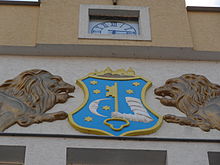Humenné
Humenné | ||
|---|---|---|
Town | ||
From the top, Panoramic view of Humenné, Vihorlat Museum, Church of Archangel Michael | ||
|
Car plate HE | | |
| Website | www | |
Humenné ( Rivers.
Names and etymology
The name comes from a common Slavic word "humno" (gumьno). In Slovak "backyard", the exact meaning may differ in dialects. Initially, a female adjective (1322 Homonna, 1332 Humenna, 1381 Humenna, 1391 Humonna) then neutrum Humenné.[4]
Landmarks
Humenné is a center of one of the easternmost districts ("okres") in Slovakia. The most attractive places are the
Castles and mansions near Humenné:
- Brekov Castle (in ruins, 7 km (4 mi) to the southwest)
- Jasenov Castle (in ruins, 3 km (2 mi) to the south)
- Čičava Castle (in ruins, 14 km (9 mi) to the southwest )
- Kamenica nad Cirochou: Classicistic mansion from 1773 (at the moment closed for public, 7 km (4 mi) to the east)
History

The Laborec river and the
An intensive and organized settlement of this area started as late as in the middle of the 13th century, after the
).The most significant town monument, a Renaissance castle, was built on the place of an original stone castle in about 1610. The castle came to be an indispensable characteristic feature of the town and serves for museum and cultural purposes at present.
In 1613, during the
In 1619, about 10,000 Polish riders—a
The Drugeth line died out in 1684 and new feudal lords moved in, notably the
The abolition of some
The Andrássy family from Transylvania started to influence the history of Humenné in the 19th century, a period characterized by economic growth. Moreover, many new buildings were erected at that time. The main fields of activities of town inhabitants were agriculture, crafts and trade. The first train appeared in Humenné in 1871, stimulating the development of trade and wood cutting. In 1899 the first business academy in Austria-Hungary was established in Humenné. Toward the end of the 19th century, Humenné counted 4,000 inhabitants.
The 20th century brought along a cultural revival. Humenné was famous for its markets and fairs. This promising, though timid, development was interrupted by World War I. A short period of the existence of Czechoslovakia between the two world wars proved to have positive effects upon the life of Humenné. As a corollary of World War II, however, all the effort had to start from the very beginning. On 26 November 1944, Humenné was captured by troops of the Soviet 18th Army, acting as a part of the 4th Ukrainian Front, after which the town became again part of Czechoslovakia.

Until 1956 Humenné was an administrative rather than an economic centre. Then the construction of a plant for the production of textile polyamide fibres, the present Chemlon company, triggered a real chain effect on the town's growth. Humenné was gradually becoming a centre of chemical, building, food and mechanical engineering industries. This had a positive impact on the development of technical colleges. The industrial development entailed large-scale housing projects, and the town area was completed by new housing estates. While there were 7,000 inhabitants living in Humenné in 1948, the population now amounts over 33,000.
Demographics
According to the 2012
In 1910, 48.6% were
Sports
Football
Humenné had one club with
Volleyball
Humenné had one of the most successful team VK Chemes Humenné in Slovak volleyball but due to dispute between owner and town about finance, club was transferred to another town Spišká Nová Ves. Nowadays no one volleyball club is in Humenné.
Ice hockey
The city's ice hockey club is
Largest companies in Humenné (2015)
- Andritz Slovakia
- Nexis Fibers
- Reinter
Notable natives and residents

- Štefan Babjak (1931-2008), opera singer
- Peter Breiner (born 1957), pianist, conductor, and composer
- Marian Čekovský, Artist
- Yuri Dojc (born 1946), Artist and Photographer
- Ladislav Grosman (1921-1981), Oscar prize winner
- František Kasanič (born 1976), professional boxer
- Slovak presidentin the modern era
- Gabriel A. Levicky, Artist[7]
- Morris Newfield (1869-1940), rabbi
- Erik Tomáš (born 1975), politician
- István Thomán (1862-1940) Hungarian piano virtuoso and music educator
- Jozef Tomko (1924-2022), cardinal
- Ágoston Trefort (1817-1888), Hungarian politician, who served as Minister of Religion and Education from 1872 until his death. He was the President of the Hungarian Academy of Sciences from 1885
- Joachim Jacob Unger (1826-1912), rabbi
- Ferenc Zichy, bishop
Twin towns – sister cities
See also
References
- ^ Statistical Office of the Slovak Republic (www.statistics.sk). "Hustota obyvateľstva - obce". www.statistics.sk. Retrieved 2024-02-08.
- ^ a b c d "Základná charakteristika". www.statistics.sk (in Slovak). Statistical Office of the Slovak Republic. 2015-04-17. Retrieved 2022-03-31.
- ^ Statistical Office of the Slovak Republic (www.statistics.sk). "Počet obyvateľov podľa pohlavia - obce (ročne)". www.statistics.sk. Retrieved 2024-02-08.
- ^ Uhlár, Vlado (1982). "Miestne názvy Humenné a Cimenná" (PDF). Slovenská reč (in Slovak) (6). Jazykovedný ústav Ľudovíta Štúra SAV: 357.
- ^ a b "Municipal Statistics". Statistical Office of the Slovak republic. Archived from the original on 2008-01-11. Retrieved 2008-01-12.
- ^ ŠK Futura priniesla pod Duklu vyššiu súťaž August 4, 2015
- ^ Gabriel, Levicky. "Gabriel Levicky (born Gabriel Levický), 1948". National Czech & Slovak Museum & Library. NCSML.
- ^ "Partnerské mestá" (in Slovak). Humenné. Retrieved 2019-09-03.
External links
 Media related to Humenné at Wikimedia Commons
Media related to Humenné at Wikimedia Commons- Page of the town Humenné
- UrbanPark - photo project about Humenné
- Childhood Dream - project about community life in Humenné



